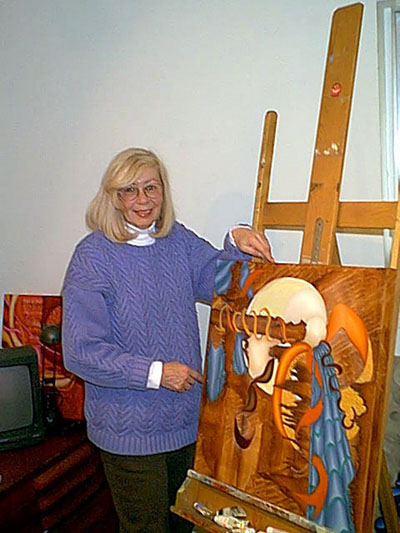

I met with Sallie Gilmore Roniss on a windy day in March at her new home studio in the Northern suburbs where she is suffering from a sort of 'lack of culture' shock. She and her husband recently moved there from their home in Rogers Park where they lived for over 30 years. She's been an active Chicago artist and art instructor since the early sixties. Her paintings can be recognized by their bright colors, textured backgrounds, exotic and lush imagery.
SGR "This one I'm just testing. I'm actually just doing this for my daughter and myself because I'm just testing the light down here."
JRM "How do you like it so far?"
SGR "I don't like the light. So my husband suggested that I move upstairs. The whole back of the house is windows. So as soon as spring breaks I can move up into one of those rooms."
JRM "That's nice you can do that. My husband wants me to paint in the basement. The light is bad, it's worse light than this."
SGR "He's going to install fluorescent and see if that helps..."
JRM "Oh fluorescent is really bad."
SGR "I'm very frustrated, he knows that so.."
SGR "In my life I've only been what you'd call an "art groupie" two times in my life where I admired someone's work for like years and set out to meet them, and become friends with them. One was Ed (Paschke) the second one was Joel Peter Witkin. Who is a pretty famous photographer. Actually, He lives in New Mexico. We were in Albequerque and I had been admiring his work for 15 years in Zoom magazine and American Photography. His work is really bizarre. We were writing back and forth. His subjects are mostly from morgues, and from mental institutions. He also does a lot of work on the backgrounds like scratching the negatives, or painting on it. We became friends. The Art Institute purchased some of his work. When it came time for him to deliver some of his work to the Art Institute, he called me and invited me to be his companion at a reception at the LaSalle Bank boardroom where they were unveiling his work. LaSalle Bank had made a sizable donation for the acquisition."
JRM "Did they know what was coming?"
SGR "They had no idea. And of course he had to do a speech and he had to display a few pieces that the Art Institute had bought. They did not know the subject or the bizarreness of his work."
JRM "How did they make the decision?"
SGR "I have no idea. Because he had shows at the Pompidou in Paris. I mean he is very famous. He's really good. He's in magazines. I think there is three or four books. He is a wonderful person. I was so glad. It took me forever to get the nerve to call him to tell him how I admired his work and how some of it had influenced me to paint what I really felt, rather than what the public wants to see."
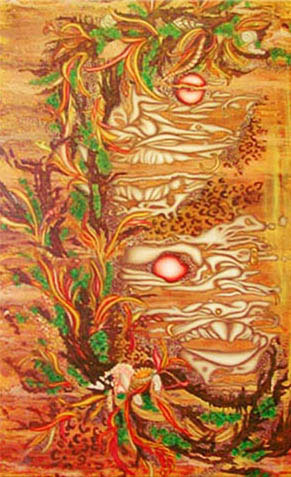
JRM "So Ed Paschke and Joel Peter Witkin are two of your major influences. Are there any other influences that you would cite? Or how else would you describe your artwork?"
SGR "I think travelling has influenced me. Different ethnic groups. Even when I was in grade school growing up in a small town in Wisconsin, I was very much interested, always, in different cultures. Because you are in a relatively small, sheltered area and my father had been in New Guinea during W.W.II. He was actually a mapmaker. One of his jobs was to go along the coast and map out the coastal regions of New Guinea for MacArthur. He brought home a lot of pictures because it was actually off limits to all service men. He had actually come upon while performing his duty the native villages and he brought several carvings back. Well, in a small town in Wisconsin that primitive art was very bizarre. But my mother was an artist and it hung in our living room. I'm sure I lost a lot of friends back in the 50's. You know because they came in and saw this. That influence made me return to New Guinea in '76. I tried to backpack the small villages that he had visited. I was successful at some. Others, because one side was Indonesia and the other side had just gotten it's independence in 1976. I collected pieces from villages. I had studied very much about their primitive artwork, and they were good pieces. I was very fortunate to spend three days with William Holden and an archeologist from the University of Arizona. The three of us."
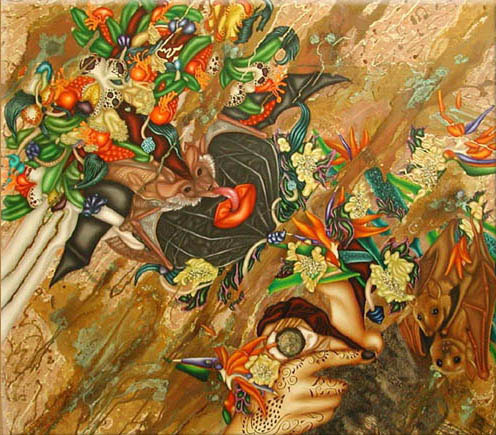
JRM "Where else have you traveled? It tends to be the primitive art and the primitive cultures that really effect you and other ethnic groups?"
SGR "In '81, I took a trip around the world by myself. I went from Europe-I spend a lot of time in India, in Thailand and a lot of time in Indonesia. In Indonesia I traveled from Sumatra all the way to Bali. That was by land and air. And I backpacked."
JRM "Wow! You were really immersed in it."
SGR "I was gone for a little over three months."
JRM "What is it about the tribal cultures' artwork that you have incorporated into your work? Is it the patterns? Or is it the forms that you saw?"
SGR "It is the patterns and the forms and what I found especially in areas like New Guinea and I suppose parts of Indonesia, in the beginning like Sumatra, where the people were fairly isolated. When they produced a piece of art, it was from looking at each other. Not necessarily looking at art reference books, or being taught to visit museums. There are no museums to visit. Or no reference. They more or less carved in the image of each other."
JRM "So when you are saying that they carved in the image of each other, that they are carving like what the person next to them is carving and like what their father carved or like what their uncle carved."
SGR "Right. Or they are carving what they think their dead ancestor looked like. Although they had never seen that person. It was just a custom. They use everything. You know they mix lye to get white, they use a root to get a terra cotta color. They use straw. They use human hair for embellishment. They use animal bones. They use teeth. They have very little to work with yet that art has to be produced. It's something that drives them. It's not just that they have a group of famous artists. It's that everybody does it. Whether it's tied to an ancestral death that they want to celebrate. Or it's even utensils that they use in daily life. If it's a gourd to collect water, they've designed it. They've done something with it. That I think, from the very beginning, just from the few pieces that my father had brought back just intrigued me."
JRM "So that sort of spontaneous flowering of just creative energy is something that you are trying to explore. Maybe it helps us to see what drives us when we take ourselves out of our own culture and see what they have in common and how it manifests in other cultures. Is that kind of what is happening to you?"
SGR "That's right. And how it is influenced by travel and by touching other people that come. Like a great instance could be where I went into a village and they really wanted, this was again in 1976, they really wanted the make-up that I had, because I had lipstick on. They also wanted the material from my jeans. I had, of course, extra jeans. We were touching on these villages along the Seepik River by boat. So sometimes it was a half a mile walk to the village from the boat. The banks were all mud. But I did manage to go back to the boat and get the clothes and make-up that they had asked me for. Well they had asked me for lipstick they didn't know anything else. And I gave it to them. On the way back along this trip, along the Seepik, I was just blown away. I thought maybe the chief wanted the blue jeans to wear, but he didn't. They all had these magnificent headdresses on. Which many people wonder how they get the feathers so perfect. Well, they take the whole bird and they pound the bird and dry it out. That's why these headdresses are so magnificent. They had blue jean material hanging down from the side of these magnificent headresses. So he just wanted the material and shared it. So everybody had a strip of blue jean. Almost like an earring, only that it was connected to their headdress. That blew me away. The same with the lipstick. They tried to paint their bodies with the lipstick because it produced a brighter red than what they could get using the soil on the ground or the root."
JRM "Well, I can identify with that. I sure enjoy wearing articles from other cultures. So I can identify with them enjoying what to them is an exotic texture or a fabulous red."
SGR "If I had had oil paints along, of course that wouldn't have dried and would have been harmful to the skin, but anything like that. They had no use for money. Where are they going to go? They always wanted to trade because that was their style-from tribe to tribe. They could do more beautiful things with gourds-even penis gourds to cover them selves. Those would be decorated. They could make use of everything. Which could teach us a lot."
JRM "Absolutely. Yeah. I have a lot of respect for people who can make art out of anything."
SGR "That's what they did."
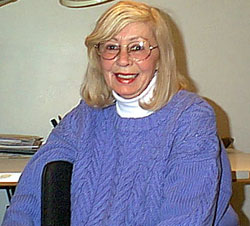
JRM "Did your travels influence your two pieces in the September 11, 2001 show at The Athenaeum? Are those a departure for you in color?"
SGR "Yes, because that was the color of Yemen. Yemen is a beautiful country. I was fortunate enough to meet an American young woman over there who had converted to strict Muslim. She took me to the Women's Center and she took me where they shop. I was absolutely astonished to be a guest at this Women's Center where they all remove their burqas, their long dresses, their gloves. In Yemen everything is covered. To my astonishment they dressed up in western clothes at this Women's Center. Much like we would play dress up when we were growing up. I mean it was O.K. for them to do this."
JRM "So the clothes were there at the center, they didn't come with them under their burqas?"
SGR "No. They would bring it to the center or it was there."
JRM "So it was kind of like going to the gym and changing."
SGR "..and playing dress-up. Their hair was dyed. They could put make-up on. They had more fun. Like dressing -up. They could do this in front of their friends."
JRM "That is so interesting.. because when I was looking at your two pieces in the September 11, 2001 show. I was looking at two pieces of women who were fully covered with these burqas, but you still get a sense of someone glamorous underneath. Somebody who is like a wonderful, beautiful flower who feels very beautiful and very feminine. Somehow you were able to capture a feminine spirit beneath a burqa. I was just blown away by those two pieces."
SGR "Yes, and they are glamorous. They are very soft, very feminine. In countries like Yemen, I was also in Oman, which is much more modern, where they don't cover the eyes. In Yemen, they keep the eyes covered. So it's even hard to see the warmth."
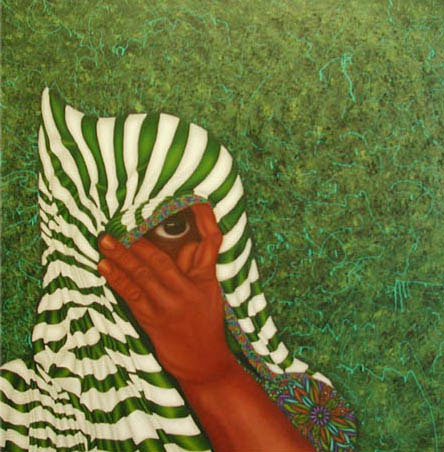
JRM "Now do they call them burqas in Yemen? Am I using the correct term?"
SGR "Yes, the burqa is the headdress. This young woman took me to stores. They had stores, and I bought one, of designer burqas."
JRM "DESIGNER BURQAS?!"
SGR "Christian Dior. Yves St. Laurent. Halston. They had designed the dresses. I bought a beautiful dress, that you and I if we had bought it in this country and shortened it would be highly stylish. But these were made for these women. The scarf would have in gold..YSL..Yves St. Laurent on the tip of the scarf. So there was even a caste system."
JRM "So they could still show status wearing the burqa?"
SGR "Status..even though they are completely covered even along with gloves."
JRM "But then they are showing their husband's status more than their own?"
SGR "Yes. Absolutely. They don't work outside the home. At the women's center they do each other's henna. Their feet are magnificent pieces of art. The women there that apply this henna are truly artists, because they can get so intricate with the design. Yet everything is covered. The hair sometimes is dyed. When I returned home the only thing they asked me for, in Yemen, again because Yemen is about the most primitive country left in the middle east, they asked me to send them Victoria's Secret catalogues Terra Verda Rosa lipstick by Clinique which they couldn't get. And dark chocolate. Underneath there... also gold was very cheap in Yemen. Underneath their burqas, the other status symbol is how many gold chains. But no one ever sees them, until they meet at the Women's Center or their own families. Beautiful gold earrings. I mean we're talking 28 karat gold. I couldn't get over how much fun they had. Like girl friends. Like what we've lost. We have it when we were 10 or 11 years and even then three can't play together. But here in this country the grown women are so close to each other."
JRM "It's like going to a disco it's so much fun for them?"
SGR "Oh they trade underwear, they have nylons on with garter belts. I mean we're talking really exotic."
JRM "They go girly-girly, huh?"
SGR "Yes. Which I would imagine they can't wear at home."
JRM "I probably would too then."
SGR "I probably would too. It's like a release. Let me dress up. She also took me to a bridal shop. Where they have their strict Muslim weddings, but they can also have a western wedding. This bridal shop had white wedding dresses much like ours. I felt so fortunate to meet these women face to face. They had a lot of questions for me and a lot of misconceptions about us. They were exposed to certain western TV programs, western movies. That's the image they had of us. We have unlimited money. We don't have many scruples. But they were judging by what they saw on TV."
JRM "It's interesting because the two pieces that you are showing at The Athenaeum right now are done in all grey, except for the areas near the lady's eyes and in certain areas of her clothing, near the figure. That was new for me to see in your work because up until that I had only seen the brighter pictures. All of a sudden you walked in with these very sensitive, grey paintings that were just luscious and still very beautiful. The change really intrigued me. That's why I needed to ask if that's a new direction that you're going. Are you kind of getting away from the rich color or.."
SGR "No it's attributed to those paintings were done when I returned. Because I really wanted in some way to make other people understand. This was before 9/11. It's really more of a, "Don't judge them". They are happy. And in some cases happier than we are, because they do have this bond with each other. We don't have time. We think we are too sophisticated to have girl friends that we can do anything with. The ones that I met at the Women's Center, they were not bored. They were not what Americans sometimes conceive because they can't drive, or they have follow behind their husband. They are not unhappy people. That is the only thing they know. They think because of the bizarre things we do, including me being able to go off without my husband. That took a lot of explaining in this women's group."

JRM "In the beginning you said that you were an art groupie two times in your life. One of those times, you really sought out the expertise of Ed Paschke. How did you become his pupil?"
SGR "I went to all of his shows at Phyllis Kind. That was years ago when she was over on Ontario. My daughter was about five years old; I wanted her not to be intimidated by galleries, like I was when I moved to Chicago. So I took her to Ed's show the morning after the opening. It was his shoe period. I was busy looking at the paintings and she was sort of wandering around. Being five and not terribly interested, but knowing that Mama painted, too. All of sudden I lost her and she was in another room, and there was a gentleman leaning down talking to her, asking her something and pointing at the paintings. And she was just answering him, which was a shock to me. Well it turned out to be Ed. He just wanted to know what she thought of the shoes. Well, naturally she thought they were wonderful, they were high heels. They were platform shoes!"
JRM "I have a daughter, so I know exactly how thrilled she was."
SGR "They had stars on them.
That was my first knowledge of how down to earth he was. It turned
out that we lived in the same neighborhood. So I called him. Every
Friday he had a workshop for a few women that he had taught. He
told me to come to his studio on Howard Street. I did. Come to
find out, there were probably about eight women up there that
he let work in the studio. Every Friday we would come up there
and paint. He would come around and critique or give us pointers
on where we wanted to go. Just seeing his huge pieces and him
working on three or four of them at a time. The pureness of the
color that he used. Over the years, I say I stayed about five
years with him. Every woman had a different personality. Every
woman was there for a different reason, I think,
because he was at his height then at Phyllis Kind. I mean he is
bigger now, I mean, he was all over as a Chicago artist at that
time. Just watching him work. We would talk. We would listen to
music. We would each have our own little spots. He really influenced
me a lot. As far as, painting what you want to paint. His work
in the beginning was relatively bizarre. Even today I hear, people
either love it or they don't like it. He does paint his characters,
which I think he probably was influenced by the studio being right
across from the Howard Street El. You would see all these characters.
A great point that he once told me, which always stuck with me
and it's so true, the west coast artists they have landscape they
have the ocean they have that influence. The east coast as well.
Chicago, we have a ride on the El. Looking at people. Taking people
apart and putting them back together. That made so much sense
to me because it's true. Later on we both loved Rogers Park. Later
on I incorporated a lot of the ethnic diversity that I saw come
and go. I lived in Rogers Park for 35 years so I saw Devon Avenue
change and change and change. I think it's wonderful because there
is every ethnic group down there. My studio was there. My home
was there. It definitely added to my ethnic influences as far
as loving other cultures. All of a sudden they were coming to
Devon Avenue. I didn't have to go to New Guinea or go to Africa."
JRM "How did you see the difference between say a New Guinea person in New Guinea and one that has moved to Chicago, that made them different?"
SGR "I think a lot of them would be lost in the beginning. Working in the park district I came across a lot of foreign people that are still coming here. They are totally lost. They would love to hang on to or to pass down to their children the code of ethics, of their religion, whether it be Hinduism, of Moslem. But the children assimilate so fast. I feel so bad for the mothers because they are losing it. The husband goes out to work in many cases the mother does not, even though she is a professional woman. The children go off to school and the woman goes shopping on Devon Avenue at the Water Street Market. She's buying what to me looks like all these exotic vegetables and fruits. I think a lot of them are lost when they first come here. That's why there's a lot of organizations that tend to be pocketed around Devon Avenue.
JRM "I've had the pleasure of contacting many of the ethnic community centers around Chicago, thank goodness they are there. In Chicago, we really do benefit from all of these different cultures."
SGR "Absolutely. I think Chicago is great for that."
SGR "On a Sunday when they are all shopping on Devon Avenue it's absolutely like any sukh or bazaar. All they need are a few cows or horses tied up on the street and you'd think you were in India or Pakistan. I would love to see that area more advertised as much as China Town or Taylor Street. My studio is interesting because one week is the Hindu parade for India and the following week is the Pakistani Independence Parade. They would do these parades down Devon to Western and then over to Warren Park on Pratt and Western. That happened to be one of my parks when I taught art for the Chicago Park District. So I got to deal with the organizers because they would end it at Warren Park where they would have festivities such as their food, craft objects. It would all end up outside because it was usually in the Spring. That's when I'm a little bit lost out here in the suburbs to tell you the truth.
SGR "I miss that diversity. It's almost void out here. Gurnee Mills you can see a little of it, but..."
JRM "You poor thing. It's like white bread out here."
SGR "I know! That's true. Where our home was, became like the Gaza Strip because that was an orthodox Jewish neighborhood. I could never figure it out because their houses would go up for sale and the Arabs would buy them."
JRM "Even though they are fighting over land in Israel they are living peacefully together here in Chicago."
SGR "Isn't that great! It's because of the food stores. They make them comfortable together."
JRM "Thank goodness. See. It could work."
SGR "See. It could work! Right. It could work. But I love Chicago. I came from a small town in Wisconsin. I moved down here on my own. With my college roommate when we finished school. We moved onto Rush Street. This was in '62, '63. When it was really, you know."
JRM "A little bit seedy?"
SGR "Old Town was just getting going."
JRM "It was just starting to get beatnikfied?"
SGR "Right! So a lot of young
single people lived around Rush Street. And I met my husband in
a bar on Rush Street. At that time we were living in Sheboygan,
my parents were begging me to come home. Because after school
my roommate and I who each had a fine arts degree and were trying
to decide
between Chicago and New York. Well, our parents said better Chicago,
it's not so far away. But I never looked back. I just love Chicago."
JRM "Where did you go to art school then?"
SGR "Layton School of Art in Milwaukee and Marquette."
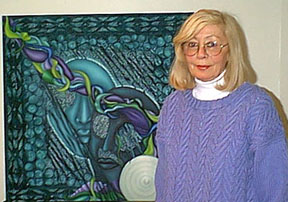
JRM "Back to Ed Paschke. Specifically, what techniques in your work did he influence you the most on?"
SGR "When I came to him, I really didn't use a lot of texture in my work."
JRM "Really?"
SGR "Yes. I was afraid to experiment with texture. I also didn't do a lot of glazing. Because believe it or not in art school they don't teach you that. They'll teach you how to draw a vase in a still life in charcoal. Of course I realize being an art teacher myself for so long, it's not something that someone can give you. It has to be inside of you. But technique..he really worked on technique. What was so wonderful about it was, he knew my love of primitive cultures and primitive objects and he was able to guide me into utilizing that in a painting. Using the textures. Using the washes. Breaking apart the elements of design and doing it my way. Rather than taking a piece of primitive art and copying the same feeling as whoever carved it."
JRM "I have seen all of that in your work and more. You are right. All of your works are you. They are not Ed Paschke, although I do see Ed Paschke's technique in them, that sort of Ed Paschke glow that you learned from him. I see the primitive, but your composition is not primitive. It's got primitive and glossy high-tech together.
SGR "And I'm trying to get the reason I'm doing the painting, that's important to me. Something from my childhood maybe, like the big purple one (Purple Pulpits) upstairs. It was a simple thing but it drove me to use that thought in the process of creating that painting. But still using my style."
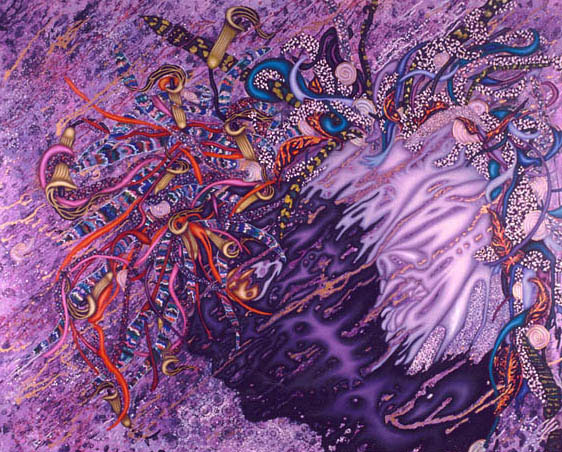
JRM "So it's sort of visual poetry. You have a feeling, a mood, a memory, and then you are putting it on the canvas."
SGR "Yes. And many times people, many times at one of my shows, I will listen to how they interpret my pieces. It's fine with me. What they see in it. It's not usually right. But it's fine with me what they come away taking with them from my work. Once they say, "Oh I like that color." Sometimes that will draw them in deeper. Sometimes I will use the color to get the attention. But I really want the composition to speak."
(End of Interview)
Although Ms. Gilmore Roniss' paintings are enticing, they are also cryptic and ambiguous. By taking a deeper look at her influences, and by studying the works of her friends and mentors, we can determine where the similarities of style and technique converge, and maybe better understand her enigmatic work.
As a group, Ms. Gilmore Roniss
and her mentors, Ed Paschke and Joel Peter Witkin, share a fascination
with the extreme facets of humanity at it's most exotic, grotesque,
perverse, and flamboyant. For Paschke it is the eccentrics, fringe
dwellers, and sleaze-pop icons of contemporary society. For Gilmore
Roniss it is a visual safari in search of the exotic, either by
backpacking in the tropics or by an expedition on the C.T.A. Joel
Peter Witkin takes the most distasteful physical
manifestations of the human form and glorifies them like unto
gods and saints of yore.
When considering Paschke's influence alone, Sallie Gilmore Roniss has learned and adapted some of his techniques into her work. Many of her backgrounds are fortuitous experiments with texture and pattern. Upon this engaging foundation, she renders that neon glow that she learned from Paschke. She does not use it pervasively, on a grand scale in her paintings like Paschke does. Instead, she uses it to add impact and another dimension to carefully selected regions amidst her ornamentally exuberant and detailed compositions. Both artists share the use of a stylized, mask-like face. They differ in that Sallie Gilmore Roniss doesn't paint literal likenesses, charicatures, or recognizable icons. The faces in her paintings are anonymous suggestions of the real people that they portray, with the surrounding symbols, realistic renderings of exotic flora and fauna, colors, and embellishments serving to express the subject's personality. Unlike Paschke's characters, who are usually active in some way by either posing saucily, playing guitar, smiling, looking over their shoulders, or adjusting their sunglasses, most of Sallie Gilmore Roniss' figures seem to float languidly or be immersed in a twilight of dreamlike reverie.
Aside from their preference for unusual human subjects, Ed Paschke's and Joel Peter Witkin's artwork has very little in common aside from Sallie Gilmore Roniss' admiration. Ed Paschke's bright, bold, and colorful paintings blaze with a contemporary American bravado, while Witkin's black and white photographs are moody, nostalgiac, detailed, and meticulously hand-crafted. Simply, Witkin's photography can be described as contemporary grotesqueries. Upon closer inspection, they are seen to be masterful applications of vintage photographic technique together with the look of aged antique prints or plates that capture a grotesque still life or portrait combined with allegorical or mythological themes.
Witkin employs malformed people
or human remains in much the same way that William Wegman uses
Wiemeraners. Witkin's subjects, though, are posed in an ironic
(choke) tableau vivant, parodying old master paintings. Gilmore
Roniss incorporates shades of the grotesque in her imagery, but
never to the point of being definable as grotesque. It is more
of a surreal device that is coyly veiled by a slick and sexy glamour.
Unlike Witkin, Gilmore Roniss uses human figures that have been
idealized and streamlined in form. Many of Gilmore Roniss' figures
are quicksilver space keepers, idealized sculptural fragments,
or masks that
are passively camouflaged within a lush background. What both
artists have in common is their impulse to express a personal
fascination. Obviously, Witkin's eroticism explores a darker and
more peculiar fetish than Gilmore Roniss' flamboyant seductions.
Both artists' work has a visual lavishness that enhances the subject
but also transcends it.
So it can be said that Sallie
Gilmore Roniss paints passive human forms that are the source
of an emotional state that is, at the very least ecstatically
introspective and possibly visionary or trancelike. This ecstatic
state of mind is poetically expressed and described by the
imagery surrounding the figure. Many of the most ambiguous figurative
pieces recall, emotionally anyway, the famous baroque sculpture
by Bernini, Ecstacy of St. Theresa. This erotic dissolution
of self and ego that appears so often in erotic art and psychology
is apparent in
Gilmore Roniss' Aquatic Albinos,
Bats of Paradise, Lizardo, Purple
Pulpits, Salquimo, Shellqua, and many others.
She can be described as a surrealist, but it is an attractive
rather than a disconcerting form of surrealism, that is more akin
to the glamour photography of Man Ray than to the disturbing images
of Luis Bunuel, or Salvador Dali. The most shocking image that
can be found in the previous list of her work is in Bats
of Paradise, where the image of a sensitively painted
bat is slipping its long pink tongue between the lips of the camouflaged
head and torso of a woman. The bats in the painting are portrayed
realistically, but they are also kind of cute, so the painting
comes across playful instead of creepy.
The idealized way that Gilmore Roniss renders some of her figures suggests that the personalities represented are passionately singular and possibly even heroic. The problem though is that any real connection with a personality is many times glossed over in favor of the cool façade and masks of a surreal commercial glamour. Often we see the trappings of exotica, but they are not enough to define a portrait of the subject's persona. One can only assume that the subject, although highly esteemed by Gilmore Roniss, is being portrayed as an erotic but disoriented figure.
References
Jean Baudrillard, Seduction, translated by Brian Singer,
New World Perspectives, 1990
John O'Neill, The Communicative Body: Studies in Communicative Philosophy, Politics, and Sociology, Northwestern Universtiy Press, Evanston, IL 1989
Georges Bataille, Erotism: Death and Sensuality, translated by Mary Dalwood, 1991 (originally published in French in 1957)
Luis Bunuel, Un Chien Andalou, Film from 1928
Cintra Wilson, Joel Peter Witkin:Is his darkly imaginative photography an intellectually camouflaged freak show or high art?, Salon.com, May 9, 2000; www.salon.com/people/bc/2000/05/09/witkin/
Images of Joel Peter Witkin's Photography can be seen at Catherine Edelman Gallery's web site at www.edelmangallery.com/witkin.htm
also at
http://zonezero.com/exposiciones/fotografos/witkin/jpwdefault.html
In the Studio with Sallie Gilmore Roniss is copyrighted by Julie Reichert-Marton March 2002